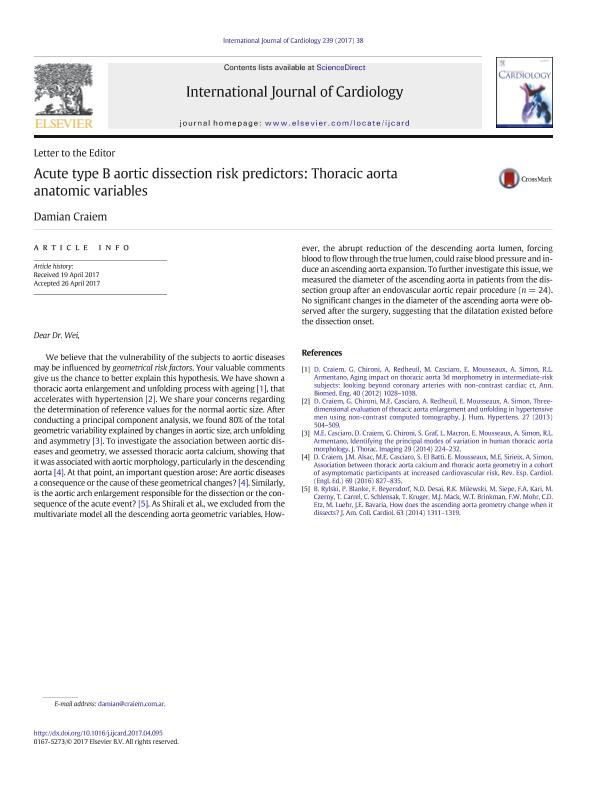Mostrar el registro sencillo del ítem
dc.contributor.author
Craiem, Damian

dc.date.available
2018-06-07T18:28:49Z
dc.date.issued
2017-07
dc.identifier.citation
Craiem, Damian; Acute type B aortic dissection risk predictors: Thoracic aorta anatomic variables; Elsevier Science; International Journal of Cardiology; 239; 7-2017; 38-38
dc.identifier.issn
0167-5273
dc.identifier.uri
http://hdl.handle.net/11336/47720
dc.description.abstract
We believe that the vulnerability of the subjects to aortic diseases may be influenced by geometrical risk factors. Your valuable comments give us the chance to better explain this hypothesis. We have shown a thoracic aorta enlargement and unfolding process with ageing [1], that accelerates with hypertension [2]. We share your concerns regarding the determination of reference values for the normal aortic size. After conducting a principal component analysis, we found 80% of the total geometric variability explained by changes in aortic size, arch unfolding and asymmetry [3]. To investigate the association between aortic diseases and geometry, we assessed thoracic aorta calcium, showing that it was associated with aortic morphology, particularly in the descending aorta [4]. At that point, an important question arose: Are aortic diseases a consequence or the cause of these geometrical changes? [4]. Similarly, is the aortic arch enlargement responsible for the dissection or the consequence of the acute event? [5]. As Shirali et al., we excluded from the multivariate model all the descending aorta geometric variables. However, the abrupt reduction of the descending aorta lumen, forcing blood to flow through the true lumen, could raise blood pressure and induce an ascending aorta expansion. To further investigate this issue, we measured the diameter of the ascending aorta in patients from the dissection group after an endovascular aortic repair procedure (n = 24). No significant changes in the diameter of the ascending aorta were observed after the surgery, suggesting that the dilatation existed before the dissection onset.
dc.format
application/pdf
dc.language.iso
eng
dc.publisher
Elsevier Science

dc.rights
info:eu-repo/semantics/openAccess
dc.rights.uri
https://creativecommons.org/licenses/by-nc-nd/2.5/ar/
dc.subject
Aortic Dissection
dc.subject
Geometrical Variables
dc.subject
Risk Prediction
dc.subject.classification
Sistemas Cardíaco y Cardiovascular

dc.subject.classification
Medicina Clínica

dc.subject.classification
CIENCIAS MÉDICAS Y DE LA SALUD

dc.title
Acute type B aortic dissection risk predictors: Thoracic aorta anatomic variables
dc.type
info:eu-repo/semantics/article
dc.type
info:ar-repo/semantics/artículo
dc.type
info:eu-repo/semantics/publishedVersion
dc.date.updated
2018-06-07T14:09:14Z
dc.journal.volume
239
dc.journal.pagination
38-38
dc.journal.pais
Países Bajos

dc.description.fil
Fil: Craiem, Damian. Consejo Nacional de Investigaciones Científicas y Técnicas. Oficina de Coordinación Administrativa Houssay; Argentina
dc.journal.title
International Journal of Cardiology

dc.relation.alternativeid
info:eu-repo/semantics/altIdentifier/doi/https://dx.doi.org/10.1016/j.ijcard.2017.04.095
dc.relation.alternativeid
info:eu-repo/semantics/altIdentifier/url/https://www.sciencedirect.com/science/article/pii/S0167527317322441
Archivos asociados
